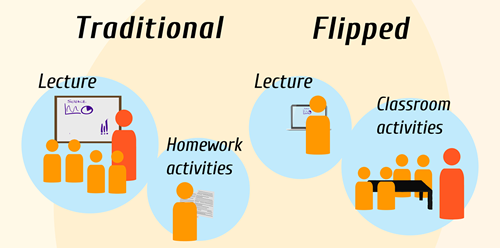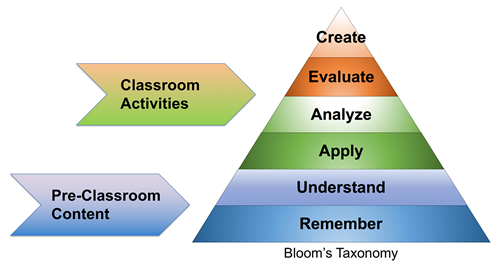Flipped Classroom (Flipped Instruction)
The flipped classroom is not new; in fact, I have been using it for all my career. It has been successfully implemented at every age level and in every subject. What has changed is the technology available and the new term "flipped" to describe this teaching technique; it used to be called the inverted classroom, just-in-time teaching and priming.
My initial implementation was really just via insight into how to make classroom time more productive and this insight came from a student (I will never forget the bright young man who saw what I did not and changed my whole philosophy of teaching). He innocently asked me if I ever get bored writing the same note on the board year after year and I stated yeah, but I try to keep it current and the goal is to help students get this information down so we can then learn what it means. He simply stated, so why don't you just not do it this way, since we find it boring too and just want to learn it with your help. So, epiphany embraced, I started with providing my notes as handouts for students to read the night before so we could move straight into discussion the next day. I was amazed at how much more productive class time became and this has been my basic technique up to about 2000.
The traditional classroom is centered around the teacher sharing information and content following which students complete homework questions and assignments designed to help them accommodate these new concepts and push their learning forward so they can, after some correction and feedback, prepare to learn the next concept. The key issue with this approach is that valuable classroom time is spent simply in transitioning learning; that is, low cognitive and low engagement activities in which content is transfered from teacher to student. Furthermore, the higher cognitive and more demanding learning takes place at home when students are on their own in terms of getting feedback, guidance and nurturing of learning. I know, when I used this method, I spent a lot of time going over the note and walking through all levels of questions following homework evenings.

The flipped classroom seeks to reverse this scenario such that students are exposed to the transfer of content as homework so that the following class time is used to deal with misconceptions and develop deeper understanding through discussion with peers and problem-solving activities facilitated by teachers. The hard part of working through understanding and application of concepts is conducted in the classroom to a much larger degree working with peers and the teacher to get immediate feedback to more aptly facilitate growth. Time is spent working with students to help them progress and in the end class discussions center on the core aspects of any concept.
Traditionally the flipped classroom was created by using assigned/targeted readings, participation in blogs, forums, etc., introductory problem solving/worksheets, quiz prep questions, tutorials and practice material. With the full development of more affordable technology and better student accessibility, the flipped classroom typically uses video lectures/screencasts/video podcasts to deliver the content and I have switched to more of this approach because it has been shown to be most effective.
In-class activities then focus more on investigating case studies, engaging in discussions centered on reflection or exploration of the content, data analysis via inquiry work, experiments and/or demonstration, peer work via small and large group analysis of concepts and problem solving.
Benefits of Flipping
There are numerous benefits associated with the flipped classroom:

I have personally witnessed all of these benefits, but the most impressive benefit has been in the amount of discussion time spent on higher-order thinking. Students come to class ready to engage with the content and share this cognitive growth with the class. In the traditional setting, class discussion centered around defining a term, correcting spelling of a word on the board and stating something again. Now, discussions center on application and analysis of the content. It is an enriching and engaging environment in which ideas are shared instead of delivered. The last two benefits, self-regulated/independent learning and multiple learning preference are paramount. These represent differentiated instruction; that is, students individually work at their own pace in a capacity that optimizes their acquisition of content. There are so many studies advocating this type of individualized instruction that is it becoming a demand of the current classroom environment. It may seem like presenting a video may not be that divergent, but the number of ways students tell me they handle the videos is quite surprising and it allows them to revisit that content in their way and at their pace and as needed.
Limitations of Flipping
That does not mean that there are not limitations (in reality, there are limitations associated with any pedagogical strategy):

My goal is to work to reduce these limitations and mitigate their impact. I have borne as much of the cost personally in terms of the hardware and software to make the videos and in terms of presentation of the content to students via the website including uploading and storage costs. Student self-discipline is an issue with any teaching strategy, but the cost of not completing the video can be higher for students who don't do their homework so this method requires greater student accountability which is actually something that defines proper learning and growth. This also is embedded in the identified global competencies which outlines proper growth and expectations for successful citizens of the future. It is not my intent to increase student workload, but it may feel that way with the increased demand for accountability. The last three limitations don't seem any different to me than what happened in the traditional classroom, but I am continually exploring methods to lesson their impact nonetheless. One limitation that is not mentioned is reduction of marks and that is because studies have found this to be false; there is either an improvement (benefit) or no change. Although I do hear concern from students in this regard, I have only experienced the opposite. I do notice that superficial marks gathered from just being exposed to the material now requires student accountability rather than merely being present and if that accountability is lacking then those marks may be harder to earn. Unfortunately chemistry is a tough subject to learn and so it seems easy to attach that difficulty to this teaching style. I have not witnessed that in any capacity. Understanding of the concepts is much improved and marks have actually risen and are much more consistent, but I have the benefit of long-term verification for this perspective.
Flipped Learning
The flipped classroom and flipped learning are often confused and treated as exactly the same thing. They are connected in that flipping is a “pedagogy-first” approach to teaching in which the subsequent in-class time is used as follow up involving inquiry, application, and assessment as teachers facilitate the learning process by helping students work through course material individually and in groups. This makes it easy to assume the terms are really the same concept; however, they are not (although, many articles and scholars continue to use the terms interchangeably). It may even appear that I have confused them above, but that is because each flows from the other; that is the boundary is actually definitive in application.
The critical difference relates to how the classroom follow up is conducted. In the flipped classroom, note-taking is completed for homework prior to the in-class work period in which students complete the traditional homework-type worksheets. This is still a valid approach and one that I do use throughout the course. However, flipped learning takes this much further by ensuring students experience active engagement via dynamic critical thinking during individual and small-group interactions and exploration of content. Within the flipped classroom, learning develops in response to work conducted to interpret and apply concepts in the traditional sense of answering questions, working through sheets and interpreting content. With flipped learning, the classroom activities are more planned to embrace differentiated learning through carefully designed activities to have students reconstruct understanding and work through misconceptions. It requires as much lesson planning and pedagogical savoy as any other higher-order thinking activity used in the classroom. It pushes students beyond their comfort zone to reconstruct understanding prior to application and problem-solving. This is direct, active and individual learning which is associated with authentic growth. Basically, with the flipped classroom, the in-class period is a work period; whereas, with flipped learning, the in-class period is a facilitated exploration of learning-centered activities.

References
Center for Teaching and Learning: Flipping the Classroom
Flipped Classroom: Fact Sheet
Higher Education Academy: Flipped Learning
Flip Learning: What is Flipped Learning
What’s the Difference Between a Flipped Classroom and Flipped Learning? by Kari M. Arfstrom
|





